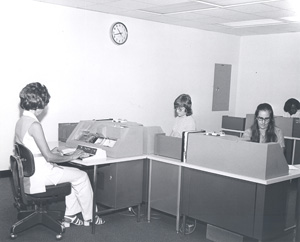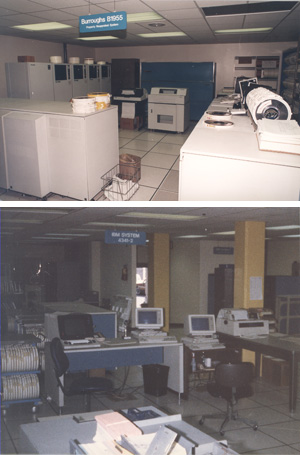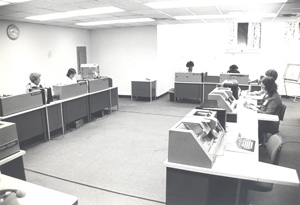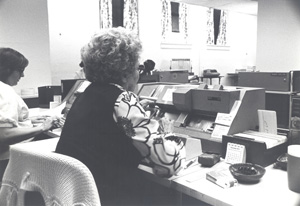
The organization that would become Information Technology Services (ITS) was born in 1972 as a "brainchild" of Metropolitan Government's first mayor, Mayor Beverly Briley, and his Finance Director Joe Torrence. i
The Mainframe Era
 Originally known as the Machine Accounting Division, the department was established as a section of the Metro Finance Department. After Mayor Briley signed Metro Bill #63-119 in 1963, "a small card-organized computer was installed and a staff of 15 people were hired" ii. The first year budget for that division of Finance was $240,000. iii
Originally known as the Machine Accounting Division, the department was established as a section of the Metro Finance Department. After Mayor Briley signed Metro Bill #63-119 in 1963, "a small card-organized computer was installed and a staff of 15 people were hired" ii. The first year budget for that division of Finance was $240,000. iii
As a standalone department in 1972, Data Processing and Computer Services (DP&CS) was organized to address the mainframe-centric computing of the time. Unlike today's environment where every employee has access to at least one personal computer for work purposes, all computing was performed directly by DP staff on car-sized computers to which "dumb" monochrome terminals were connected. These terminals were dumb in that without a wired connection to the mainframe itself, they were equivalent of a monitor alone today.
 Throughout the 1970s, computer operations for departments were managed by specialized staffs who were employees of the centralized DP department. Simplified, work on the mainframe was done via programs written by the Data Systems section of DP, scheduled in batch jobs by the Data Control section, and loaded and run on mainframe computers which were managed by the Computer Operations section. Mainframe operating systems were managed by the Systems Support section with customer information input by a dedicated set of Data Entry section staff, who converted all information needing to be processed onto paper punch cards that could be read by the system. Printed output was available which was delivered back to the requesting department.
Throughout the 1970s, computer operations for departments were managed by specialized staffs who were employees of the centralized DP department. Simplified, work on the mainframe was done via programs written by the Data Systems section of DP, scheduled in batch jobs by the Data Control section, and loaded and run on mainframe computers which were managed by the Computer Operations section. Mainframe operating systems were managed by the Systems Support section with customer information input by a dedicated set of Data Entry section staff, who converted all information needing to be processed onto paper punch cards that could be read by the system. Printed output was available which was delivered back to the requesting department.
This model of operation existed into the 1980s with little practical change in methodology for Metro Government. Customers of the centralized Data Processing department included Finance, the Courts, General Hospital, MDHA, Metro Nashville Public Schools, Trustee, Assessor of Property, Personnel, Planning, Public Works and many others.
Metro Governments mainframe age ended when the last mainframe was sold for scrap and removed from the original ITS data center in 2009. That data center, which had seen countless punch cards processed and magnetic tape reels mounted since its opening in 1973, was itself shut down in 2010 as ITS migrated all systems to the new, state-of-the-art Metro Government Primary Data Center. The new data center today hosts hundreds of servers and systems for ITS customers and celebrated its fifth anniversary in April 2015 with the announcement of zero downtime over its five year history.
The Personal Computer Era
In the computing world outside Metro Government, seismic shifts were occurring. In the late 1970s, the first personal computers became commercially available. Metro Government got on board through the purchase of IBM Personal Computers and PC “clones.” These PCs were attached to a Metro Government Token Ring network and utilized software allowing the PCs to communicate with a mainframe, the computing model that dominated Metro's computing environment.
 In the early 1990s, a true client/server environment running IBM servers and IBM PCs was installed, all of which were based on the micro-channel architecture. These proprietary systems used a graphical user interface, or GUI, centered around IBM Office Vision running on the OS/2 platform.
In the early 1990s, a true client/server environment running IBM servers and IBM PCs was installed, all of which were based on the micro-channel architecture. These proprietary systems used a graphical user interface, or GUI, centered around IBM Office Vision running on the OS/2 platform.
The administration of Mayor Phil Bredesen brought a vision of opening up the client/server platforms to a more open architecture design without being brand specific. The early days of this new direction brought an environment wherein servers and desktops from many different vendors were bought which ran diverse software. This proved to be a difficult environment to manage due to the many different brands of hardware with little standardization across the government. A reaction to the difficulty in managing this environment paved the way for today's environment which is primarily standardized on Microsoft software and Dell hardware.
 Mayor Bredesen also reversed the decision made a decade earlier that had brought the Data Processing department back into the department of Finance as a division. The Information Systems Department (ISD) emerged as a result of Metro Bill 093-687. The decision was based in a finding in the Efficiency in Metropolitan Government Task Force Final Report of 1989, a report that had been initiated by Bredesen's predecessor Mayor Bill Boner. The Task Force recommended an Information Systems Director position as well as the consolidation of the data processing function of the Department of Finance, Metro Water Services and the Metro Nashville Police Department into ISD.
Mayor Bredesen also reversed the decision made a decade earlier that had brought the Data Processing department back into the department of Finance as a division. The Information Systems Department (ISD) emerged as a result of Metro Bill 093-687. The decision was based in a finding in the Efficiency in Metropolitan Government Task Force Final Report of 1989, a report that had been initiated by Bredesen's predecessor Mayor Bill Boner. The Task Force recommended an Information Systems Director position as well as the consolidation of the data processing function of the Department of Finance, Metro Water Services and the Metro Nashville Police Department into ISD.
In addition to creating the body that exists today as ITS, Mayor Bredesen and the Metro Council also established the review function of ITS through the statement in Metro Code section 2.24.110 that “All functions relating to computer information systems or data processing conducted by the metropolitan government shall be reviewed and evaluated by the Department of Information Systems to determine whether the functions are feasible and the availability of alternatives.”
IT Consolidation
While the director position was created, not many other aspects of consolidation were implemented under Mayor Bredesen. Efficiency of operations were also a focus for the administration of Bredesen's successor Mayor Bill Purcell. As the computing industry had matured and technologies like email, wide area networks and personal computers became commonplace, so had broader awareness of the efficiencies and economies of scale available through targeted consolidation of services.
ITS Director Richard McKinney led a collaborative initiative to consolidate services within the general government that were considered duplicative and that could be standardized and efficiently managed by a single organization. This included consolidation into the central information technology department of desktop support technicians, server management, email systems and network management from other departments. This was a tough process for many who lost staff members and some level of control over their environments in return for a promise of efficiency and an ITS department with a commitment to customer service.
Though the consolidation was not comprehensive in that it was not intended to and did not eliminate all duplication of services, it did lay the groundwork for the single email system used by the general government (from ten independent departmental general government systems) and a single wired and wireless network. As significant was the consolidation of over 70 Netware and NT domains to one centralized Active Directory (AD) environment for authentication and access. Prior to this AD consolidation, if an employee needed access to files in each domain, it required 70 different accounts and passwords.
Probably the most significant consolidation was of the wired network infrastructure from several disparately managed networks to a single network managed by the central IT organization. Due to the complexities of having multiple separate networks within a single organization like Metro Government, there were constant communications issues between departments and agencies. Implementation of the Metro-wide SONET network technology built on a fiber-optic backbone was a key foundational piece. This backbone later made possible the implementation of a wireless (wifi) network for employees in the 2000s and in 2013 the rollout of Free Public Wifi for the public at government facilities such as parks, community centers and government service locations.
In many ways Metro Government led the rest of the country in that it helped demonstrate the value of services consolidation and shared IT services that is now standard procedure in the private sector and at federal, state and local government levels.
It was also at the time of consolidation that the organization was rebranded as Information Technology Services, or ITS and its director was given the title of Chief Information Officer. Consolidation has continued on a smaller scale ever since, with the 10-person Enterprise Business Systems (EBS) division of the Finance Department moving into ITS in 2011, and other services migrating to ITS as the benefits of consolidation become evident to departments and agencies.
The Internet Era
Metro Government's first website was developed and released during the winter of 1994 by Information Systems staff on a spare Windows NT server. Several staff members were interested in the newly created World Wide Web and had created and posted a few pages about Metro online to test it out. The homepage layout was "default gray" since background images were not supported by browsers of the period. The site was shown to Mayor Bredesen, who liked it, and asked that it go live to the public.
That seminal site was not registered as Nashville.gov, but rather Nashville.org. The basic content of the site consisted of Mayor Phil Bredesen's biography, a list of departments and their corresponding phone numbers, and the Metro Government Civil Service Rules.
In a move that garnered national attention, in 1996 Metro teamed up with local internet providers TeleLink, EdgeNet, and ISDN-Net to form City-Net iv. This consortium built a local network that segmented internet traffic locally via regional routing to improve local internet transfer performance.
As web technology rapidly advanced, so did Metro Government's web presence. Comprehensive updates to website design and content happened in 1997, 1998, 2000, 2001 and 2007. The latest iteration of Nashville.gov went live in January of 2013 featuring a fully responsive design that makes it usable across various screen sizes of PCs, laptops and mobile devices. This is critical as mobile device use continues to expand, and makes up greater than 40% of all Nashville.gov usage in 2015 v.
Information Security Focus
On Christmas Eve 2007, a homeless man broke an exterior window and entered the offices of the Election Commission on the first floor of the Metro Office Building. While inside the building he stole several pieces of electronics, including a laptop from a desk that contained the poll list of all 337,000 registered Davidson County voters for an upcoming election. vi Because the information was for internal departmental use, the poll list contained personally identifiable information, causing countywide concern for possible citizen identity theft. After a well-publicized manhunt, both the thief and the laptop were found and it was forensically shown that the data had not been accessed. Thus the Metropolitan Government received a louder wake-up to the realities of information security than do most governments.
As a result, Mayor Karl Dean implemented a number of executive orders that defined information security as a focus for Metro departments and agencies. The executive orders established policy ownership within ITS as well as internal governance processes and training and awareness activities. They also established a mayoral advisory group, the Information Security Advisory Board (ISAB), as a group of private sector information security experts outside Metro Government to advise the initiative's leaders.
Public, Educational and Government Television
Metro Government has franchise agreements with a number of cable television providers to allow them use of Metro's right of way. In return and in addition to franchise fee payments, these agreements provide Metro the rights to offer four public, educational and governmental (PEG) channels to be broadcast on franchisees' cable system. Via addition to the Metro Code of Law from 1979, oversight for these channels is the responsibility of ITS through its role as the Office of Telecommunications.
Originally known as the Government Access Channel, Metro 3 is operated as a division of ITS and broadcasts meetings of boards and commissions and provides video services for Metro departments and agencies. Metro 3 manages live broadcasts of meetings on a weekly basis from control rooms in the Historic Courthouse, the Howard Office Building, and the Bransford Avenue headquarters of Metro Nashville Public Schools.
The other three channels were initially managed by the now defunct Metro Educational Access Corporation (MEAC) and the Community Access Corporation (CAC). In 2010, MEAC and CAC were consolidated into one organization after a collaborative process with their communities of users. These organizations merged into Nashville Educational and Community Access Television (NECAT).
In the 1995 franchise agreement, franchise fees from cable provider Intermedia allowed for the construction of the PEG Studio on the Nashville State Community College campus. Metro Government continues to lease this property for this use under agreement with Nashville State for $1 per year. In 2010 to coincide with the creation of NECAT a new division of ITS was formed named PEG Studio Management to provide site and inventory management for the PEG Studio in support of NECAT and their mission.
The Cloud Era
In 2015, the Cloud is the current trend in technology that Metro has begun to embrace. Cloud computing, using a service hosted remotely by a provider via an internet connection, can be viewed as another iteration of the centralized server model seen in mainframes. Cloud technology became viable over the past 10 years as network speeds within organizations and over the Internet improved and applications or services became available from private sector providers.
While ITS has provided an internal cloud for customers for a number of years, externally hosted and cloud-based technologies have been used when systems have been large, complicated and require considerable specialized staffing. Metro Government's enterprise resource planning (ERP) system for finance, accounting and human resources, Enterprise One, has been hosted since 2005. More recently in 2014, Metro Government implemented its first enterprise cloud-based system in Kronos Time and Attendance.
Another cloud service that Metro implemented across the government was the Open Data portal. Open data is the concept wherein data within a government is actually the property its citizens, and should be made available to them proactively and with little impediment assuming there is no compelling reason not to do so. ITS was instrumental in co-authoring with the Mayor's Office of Innovation Mayor Dean's Open Data Executive Order of 2014, which laid out a thought pattern for Metro departments. The portal is hosted by Socrata and managed by ITS but coordinated by a collective of data owners from across Metro Government departments and agencies.
In Summary
"The demand for new data processing systems far exceeds the present capacity for developing them and it is anticipated this will continue in the future" were words written in 1981 about computer technology at Metro vii. While the author could not have fathomed that almost 25 years later the situation would continue and has accelerated, the Information Technology Services of 2015 is positioned to meet those challenges, building on the successes and lessons learned of the past fifty years of computing.
Written by Chief Information Officer and Director of ITS, Keith Durbin, with many thanks to Connie Chitwood, Tim Hollingsworth, Greg Lewis, and Steve Nelson for their memories and who between them have 127 years of service to the Metropolitan Government in information technology.
Leaders of ITS and Predecessor Organizations
- Ronald P. Dickie, Director (1972-1980)
- Sara Fitzgerald, Director (1980-1983)
- Twila Hicks Brent, Interim Director
- Tom Clark, Director, (1984-1986, 1986-1993)
- Don Mast, Interim Information Systems Coordinator (1986-1986)
- Gus Alfaquih, Director (1993-1996)
- Dennis Achilles, Director (1997-1999)
- Richard McKinney, Director and Chief Information Officer (1999-2005)
- Sandy Cole, Director and Chief Information Officer (2006-2008)
- Keith Durbin, Director and Chief Information Officer (2009-2024)
- John Griffey, Interim Director and Chief Information Officer (2024-present)
Footnotes
i. According to a 1973 document titled Metro in Computer Age.
ii. According to a 1981 document titled Metro Government Data Processing and Computer Services.
iii. This is equivalent to over $1.7 million 2014 dollars when adjusted by the Consumer Price Index.
iv. Nashville's Internet Traffic Success, GovTech.com
v. Per Google Analytics reporting for Nashville.gov.
vi. Election commission breach leads to better e-security, Nashville City Paper
vii. From the 1981 document titled Metro Government Data Processing and Computer Services.
